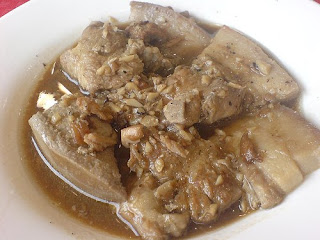
First of all, let me greet friends and bloghoppers a Merry, Merry Christmas!
Let me share some of the desserts in our Noche Buena table last night. Noche Buena is a time-honored Filipino tradition where members of the family eat together a simple or lavish Christmas Eve feast, whichever way you like it. This happens by midnight, usually after hearing Mass. Gifts are distributed or exchanged, also during this time.
As this is our first Christmas in our new home, we put up our own seven-foot Christmas tree and a twinkling parol (lantern) outside. Our Christmas meal, however, was what I would call the "no sweat" noche buena. I passed on working in the kitchen, with a promise to really get-busy in the New Year. Maybe am still just recovering from a much-needed break from work.
So here it is, the desserts on our table:
Gingerbread house - very pretty! I bought this from S & R thinking it's something the kids would admire, and they did! It's completely edible, but we still have to eat it!
The Christmas Cake - most reputable bakeshops sell this. Ours was from Red Ribbon - white frosting decorated with green and red Christmas trimmings.
Leche Flan - A whole round pan from Goldilock's, with a thick custard. My son, who has a sweet tooth, simply loves this.
Chocolates, Ferrero Chocolates - everybody's favorite.
Note : Except for the Gingerbread House, the Sweetheart sent all of these, via online delivery. He wanted to spare me the hassle of cooking and baking, hehe. Not in photo is the ice cream, chilling out in the ref ;)





